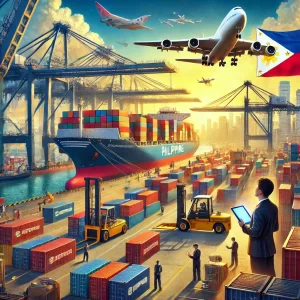In the world of international trade, paperwork is often as crucial as the products themselves. Among the various documents necessary for smooth trade transactions, the Certificate of Origin holds significant importance. For businesses operating in the Philippines, understanding the intricacies of obtaining and utilizing this certificate is paramount. Join us as we delve into the depths of Certificate of Origin in the Philippine context.
What is Certificate Of Origin?
Before delving into specifics, let’s grasp the essence of a Certificate of Origin (CO). Essentially, a CO is a document certifying the country where the exported goods were manufactured, produced, or processed. It serves as evidence for the importing country that the goods originate from a specific place, and it may entitle the importer to preferential duties or other benefits under trade agreements.
Importance of Certificate of Origin: In the global market, where trade agreements and tariffs heavily influence business dynamics, a Certificate of Origin can significantly impact the cost and efficiency of international transactions. Without it, shipments may encounter delays, face additional fees, or even be rejected at customs. Therefore, businesses must ensure compliance with CO requirements to avoid disruptions in their supply chains.
Certificate of Origin in the Philippines: Now, let’s focus on the specific landscape of Certificate of Origin procedures in the Philippines. The Philippines utilizes COs to facilitate international trade, adhering to established protocols and agreements. The Philippine Chamber of Commerce and Industry (PCCI) is one of the recognized authorities for issuing COs in the country. Additionally, certain industries or products may require specialized COs or endorsements from specific agencies.
Subscribe to the Ex-works24/7 newsletter
Process of Obtaining a Certificate of Origin: Obtaining a CO in the Philippines involves a structured process that varies depending on the destination country, the nature of the goods, and any applicable trade agreements. Generally, the process entails the following steps:
Document Preparation: Gather necessary documents, such as commercial invoices, packing lists, and proof of origin.
Application Submission: Submit the required documents to the designated issuing authority, such as the PCCI or relevant government agencies.
Review and Approval: The issuing authority reviews the application to ensure compliance with regulations and verifies the authenticity of the provided information.
Issuance of Certificate: Upon approval, the Certificate of Origin is issued, typically in a specified format and containing relevant details about the goods and their origin.
Tips for Successful Certificate of Origin Application: Navigating the CO process can be complex, but adhering to certain best practices can streamline the experience:
Plan Ahead: Begin the CO application process well in advance of the shipment date to account for any potential delays.
Ensure Accuracy: Double-check all information provided in the application to avoid errors or discrepancies.
Stay Informed: Stay updated on relevant trade agreements, tariff schedules, and regulatory changes that may impact CO requirements.
Utilize Resources: Seek guidance from trade associations, customs brokers, or government agencies to navigate the CO process effectively.
Conclusion: In the realm of international trade, the Certificate of Origin serves as a vital document, facilitating the smooth flow of goods across borders. For businesses operating in the Philippines, understanding the nuances of CO procedures is essential for ensuring compliance and minimizing trade-related risks. By navigating the CO process with diligence and expertise, businesses can unlock the benefits of international trade while navigating regulatory complexities effectively.
Frequently
Asked Questions
A Certificate of Origin (COO) is an official document used in international trade to declare the country of origin of goods being exported. It certifies where the products were manufactured, grown, or processed, and it is required by customs authorities in the importing country. The COO helps determine the correct tariffs and whether the goods qualify for any preferential treatment under free trade agreements or trade preferences.
There are generally two types of COOs:
- Non-preferential Certificate of Origin: Used to determine the origin of goods for the purpose of applying standard tariffs.
- Preferential Certificate of Origin: Used when goods are eligible for preferential tariff rates under free trade agreements or regional trade arrangements (e.g., ASEAN, EU, or US-Philippines Free Trade Agreement).
The Certificate of Origin serves several purposes in international trade:
- Customs Clearance: Many countries require a COO to ensure that imported goods meet the requirements for customs clearance and to calculate the correct duty or tax.
- Tariff Preferences: It is necessary for goods to qualify for preferential tariffs or duty exemptions under bilateral or multilateral free trade agreements (e.g., ASEAN, WTO, GSP).
- Trade Compliance: It helps the importing country monitor trade flows and ensure compliance with rules of origin stipulated in trade agreements.
- Anti-Dumping and Safeguards: COOs help prevent trade violations, such as the circumvention of anti-dumping duties or safeguard measures by incorrectly declaring the origin of goods.
A Certificate of Origin is typically issued by an authorized body in the exporting country, such as:
- Chamber of Commerce: In many countries, local or national chambers of commerce are the primary authorities authorized to issue COOs.
- Customs Authorities: Some countries have government customs agencies that may issue COOs, especially when the goods are subject to specific customs regulations.
- Industry Associations: Certain industries or product-specific bodies may also be authorized to issue a COO (e.g., agricultural products, textiles).
- Freight Forwarders or Exporters: In some cases, businesses or freight forwarders can provide a COO if they are part of a recognized trade or logistics network.
The document is typically stamped or signed by the issuing authority to verify its authentic
A Certificate of Origin includes various pieces of essential information, such as:
- Exporter Details: Name, address, and contact information of the exporter.
- Consignee Details: Name and address of the buyer or importer.
- Description of Goods: A detailed description of the goods being exported, including their nature, quantity, and sometimes the HS Code (Harmonized System code).
- Country of Origin: The country where the goods were wholly produced, manufactured, or significantly transformed.
- Origin Certification: A statement confirming the origin of the goods, usually signed or stamped by the issuing authority (e.g., Chamber of Commerce).
- Harmonized System Code (HS Code): Classification of goods according to international standards.
- Transport Details: Information about the shipment, such as the mode of transport (sea, air, road) and vessel name or flight number (if applicable).
- Preferential Treatment Information: If applicable, details about whether the product qualifies for preferential treatment under trade agreements (e.g., ASEAN Free Trade Area).
The primary difference between a Non-Preferential and Preferential Certificate of Origin lies in the trade benefits they provide:
Non-Preferential Certificate of Origin: This is the most common type of COO. It simply certifies the country of origin for goods but does not entitle them to preferential tariff rates. It is used for determining the origin of goods for customs purposes, without any preferential treatment under trade agreements.
Preferential Certificate of Origin: This type of COO is issued when goods are eligible for preferential tariff treatment under a free trade agreement (FTA) or preferential trade scheme (such as the Generalized System of Preferences - GSP). This means that the goods may be subject to lower or zero tariffs based on their origin, encouraging trade between member countries. To qualify, the goods must meet specific rules of origin set out in the trade agreement (e.g., certain percentage of local content or value added).
A preferential COO can reduce the duty rates and lower the cost of goods when imported into a trading bloc, while a non-preferential COO does not grant such benefits.




